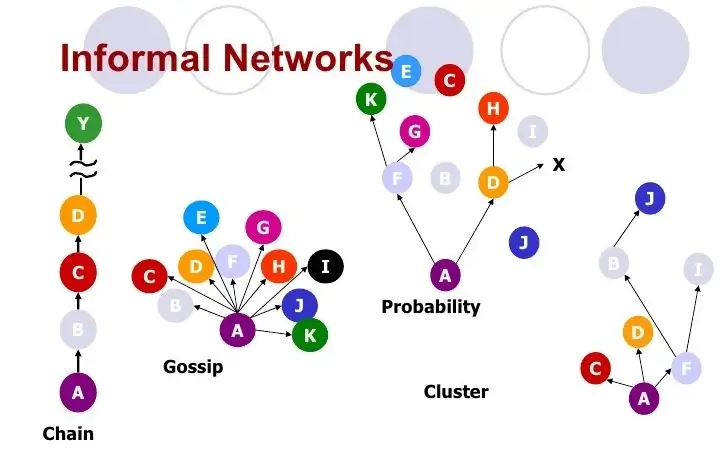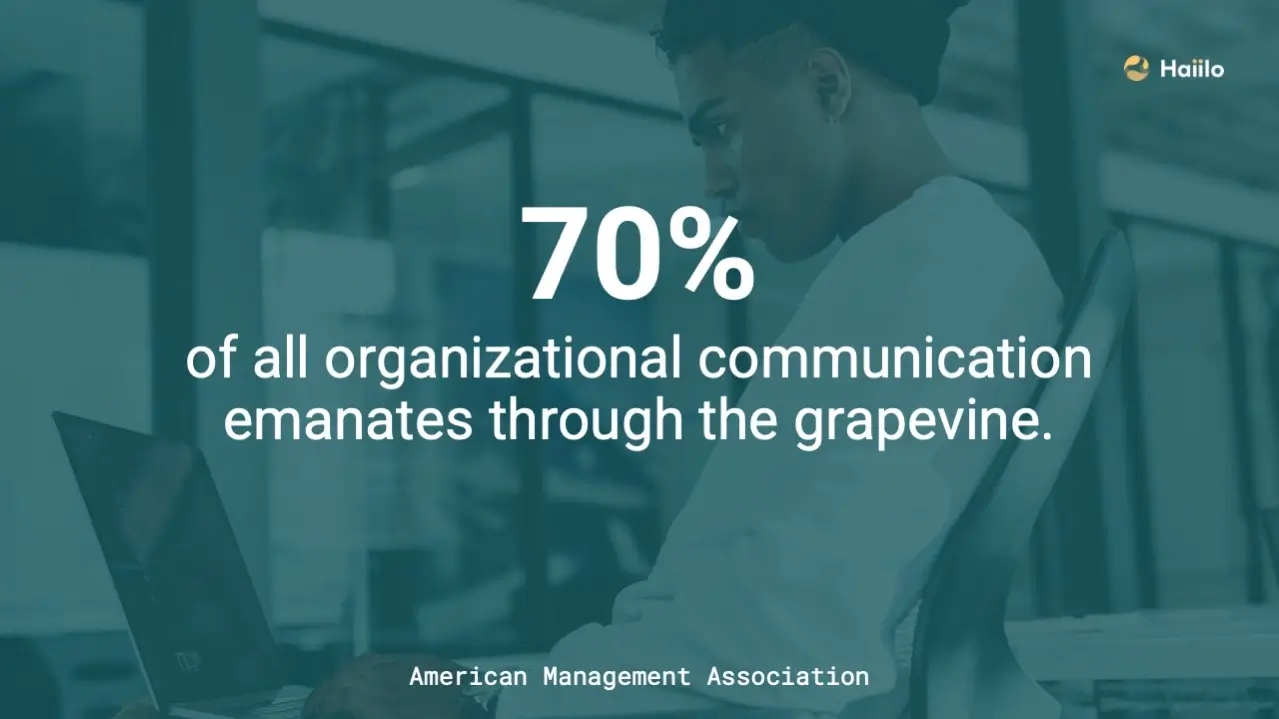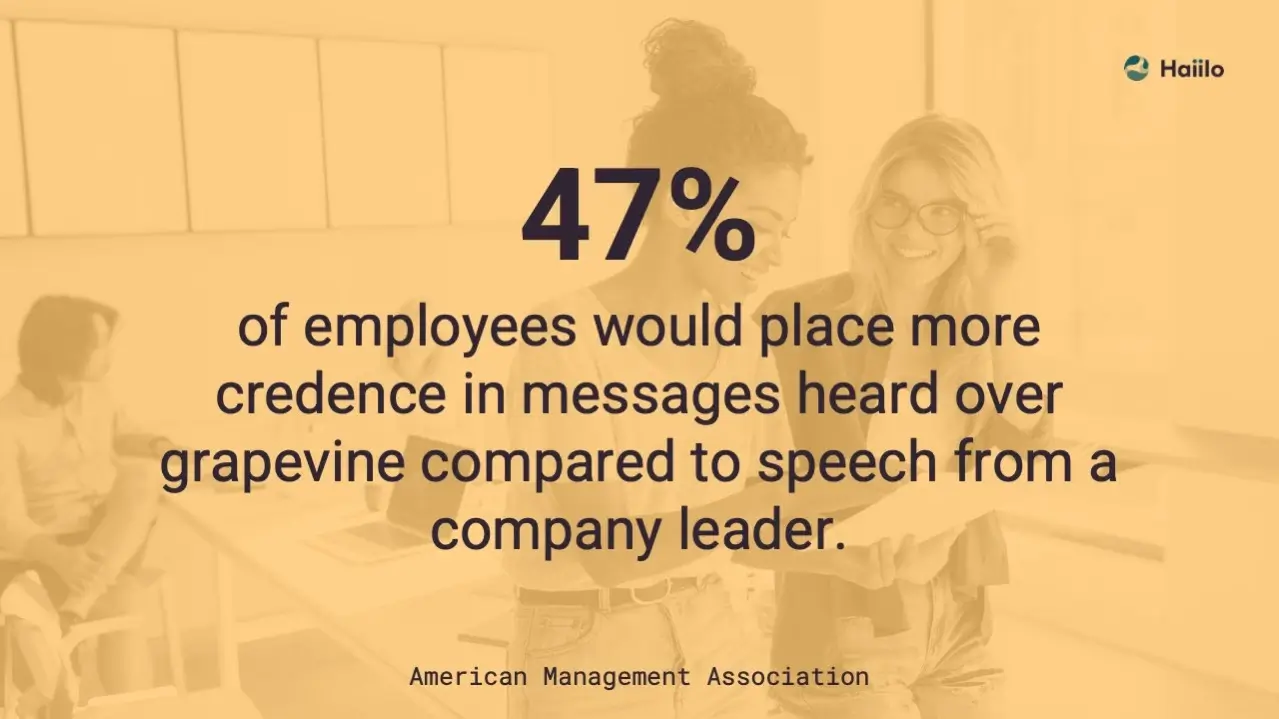Grapevine communication happens in every organization, no matter the company size or industry. This informal type of communication may have a significant impact on the employee experience you can deliver as well as your business performance and your ability to build trust with your employees.
In this blog, we will explain what grapevine communication is, and we will go over some tips to help you deal with this type of communication in the workplace.
Tackle grapevine communication by implementing the right IC tool!
What Is Grapevine Communication?
According to Prof. Keith Davis, a well-known professor for his research on grapevine communication, this type of communication arises from social interaction and is as varied as people are.

Unlike communication via emails, intranets and other formal communication channels in the workplace, grapevine communication is the informal way of communication that happens within organizations.
Even though some employers try to prevent and stop grapevine communication, it is an inevitable part of business life, with the American Management Association estimating that fully 70% of all organizational communication emanates through the grapevine. Moreover, most employees deem it trustworthy as well.
As grapevine communication is mainly based on the spoken word, such as the “water cooler talks,” it can be impossible for employers to track it and understand the negative consequences grapevine communication can have on their workforce.
📹 Before we move to the next section, watch our Masterclass about how to tackle the biggest communication barriers in the workplace.
4 Types of Grapevine Communication
Grapevine communication does not have one definite pattern or direction, though it is mostly horizontal in nature. However, it can go horizontally, vertically and even diagonally.
In order to better understand how grapevine communication happens within organizations, it is important to be aware of the various types of chains through which information can flow.
Prof. Keith Davis, who has done extensive research on the nature of grapevine communication, has classified it into four basic types:

- Single Strand Chain: The single strand chain involves passing information through a line of persons to the ultimate recipient.
- Gossip Chain: In the gossip chain, one person seeks and tells the information to everyone. This chain is just like the wheel where one person stays at the center and passes the information to other employees.
- Probability Chain: The probability chain is a random process in which someone transmits the information to others in accordance with the laws of probability, and then these others pass the information in a similar way.
- Cluster Chain: In the cluster chain, a person tells the information to the selected people, who may, in turn, pass the information to other selected people.
The Negative Sides of Grapevine Communication in the Workplace
The main danger of grapevine communication in the workplace is that much of the information that gets spread through the grapevine is not verified. Oftentimes, such information is difficult, if not impossible, to track.
Employers need to understand that when false and unverified information is being spread through the grapevine, people’s reputations, careers, and lives can be harmed very rapidly.

Let’s take a look into some of the negative sides of grapevine communication in the workplace:
- Lack of trust in the workplace: When communication via formal and informal channels is not consistent, employees may loose trust in their employers and leaders. As trust in the workplace is crucial for employees’ experience and productivity in the workplace, this is one of the main reasons why many employers are trying to eliminate grapevine communication as much as possible.
- Partial or false information in the workplace: When talking about informal means of communication that are not documented, employees often hear or remember only parts of the messages which often results in the spread of non-reliable, false information.
- Misunderstanding and misinformation in the workplace: When unverified information flows through the informal communication channels, this creates the opportunity to develop misunderstanding among employees.
- Information overload: On a daily basis, employees deal with so much information coming their way even without grapevine communication. Within unhealthy workplaces with a lot of rumors and gossip, this struggle is even more obvious, and it negatively impacts employees’ wellbeing and productivity.
- Maintaining secrecy: In grapevine communication, communication is made by open discussions. Therefore, it is often impossible to maintain the secrecy of important information.
- Lack of control: Under informal communication systems, there are no established rules or policies, so it is very difficult to control the information flow and credibility.
- Lack of cooperation among employees: This is considered one of the biggest negative sides of grapevine communication. It can develop an adversary culture among employees, resulting in less collaboration among employees.
- Employees may end up not being aligned with the company’s goals. When there’s no clear internal communication strategy, it becomes highly challenging to align employees with the business goals. Each employee may have a different understanding of the company culture, your mission statement, and your top business goals. What’s more, your employees may not have a clear understanding of how their work impacts the business. Put differently, grapevine communication may have a negative impact on your workplace productivity and your business’s success overall.
6 Ways to Deal with Grapevine Communication
There is no way to eliminate or stop grapevine communication in the workplace. However, there are ways to better understand it, control it, and eliminate the negative sides grapevine can bring to your company by ensuring proper employee communications via formal communication channels.
Having dedicated employee communications channels at your workplace will help you support your employees’ productivity, all while aligning your organization.
Let’s take a look into some best practices:
1. Always keep your employees informed
The best way to prevent or reduce grapevine communication is to always provide credible and easily accessible sources of important information. Yet, many organizations, especially large enterprises, struggle to achieve that.
As the communication ecosystem in the workplace has become extremely complex, companies are struggling to streamline the information flow in their workplaces. As a consequence, employees often feel confused, they miss out on important information, and they are less productive while wasting their time looking for the information they need.

Post 2020 employers are more aware of the importance of putting relevant and important information at their employees’ fingertips. Therefore, many of them are now trying to find the best ways to keep their remote and on-site employees connected and informed.
Within workplaces that neglect the importance of real-time communication, the grapevine effect is inevitable. Employees will talk and comment with each other about every new step and decision you make. What’s more, their opinions, concerns and beliefs will reach a much broader audience.
Instead of waiting for employees to make their own conclusions, organizations are the ones who should make sure that the right information always reaches the right employees at the right time.
2. Choose the right communication channels to build trust with your employees
As mentioned earlier, trust in the workplace has a big impact on employees’ motivation, engagement and, consequently, their productivity and success.
Yet, according to the Edelman “Trust Barometer” (a survey of 33,000 people in 28 countries), one in three people don’t trust their employer. This is especially true when it comes to trusting leaders and C-level executives.
The AMA uncovered some conflicting findings on the role of grapevine communication in an organization. For example, when asked if employees would place “more credence in a speech from a company leader or in a message heard over the grapevine,” 47% of respondents chose the grapevine.

On the other hand, when asked if they would believe a message delivered over the grapevine or what they hear directly from their direct supervisor, 74% of respondents chose their supervisor.
By directing information through informal channels, you can affect what information is spread through the office. The study also showed that when leadership and grapevine messages were conflicting, 47% of people will believe the grapevine, 42% will believe senior management and the remaining 11% are undecided.
Therefore, leaders have a long way to go to build trust in order to be more credible and considered trustworthy by their employers, and effective leadership and manager communications are the only ways to achieve that. Leaders need to be approachable and communicate with an authentic voice. They need to really understand their role in internal communications and make sure that their messages don’t get unread by the employees.
3. Eliminate information overload in the workplace
Employees are dealing with an extensive information overload in both their private and professionals lives, especially during the past few months.
Sometimes, it can be extremely hard to filter through that information and consume only the content that comes from credible sources. In this information chaos, grapevine communication will happen no matter what.
Therefore, it is the employer’s responsibility to share the most relevant information from credible sources with the employees. This, however, is not an easy job at all!
Imagine going through every single source of information every time before you want to share external content with your employees. Unfortunately, this can be a very time consuming job for your internal communications departments.
Instead, IC departments should be able to automate the content import from sources they have identified as trustworthy and relevant to their employees. That way, there will be much less room for rumors and grapevine communication in the workplace.
Furthermore, internal communications departments, leaders and managers should have the ability to easily filter and segment their internal audiences so that information that employees get is localized, relevant to what they do, their locations, job functions, and the languages they speak.
This is how Haiilo does it!

Today, when workplaces are highly dispersed, it is crucial to stay relevant while providing timely, accurate and personalized communication.
4. Engage your employees in two-way daily conversations
Hierarchical companies with closed company cultures are much more likely to experience the negative sides of grapevine communications. Within such organizations, employees don’t feel like they are free to share their voice, raise questions and talk about their needs and concerns.
However, employees will still talk among each other about those matters, and the information will spread more quickly that you can imagine.
Wouldn’t it be better to build a company culture of honest and open communication where employees feel safe to speak up, a culture where two-way communication comes before one-way communication?
Now is the time for employers to understand that the days when we would just send out a newsletter with company updates to the entire workforce are over! If this is how you approach employee communications, you have probably already realized that such information is often ignored and has very low consumption rates.

Internal communications professionals are now looking for ways to create more engaging content, give employees the ability to join the conversation and drive healthy workplace relationships among peers and managers no matter where they are located.
5. Spot your internal influencers
Your internal influencers — your employees that other people listen to and trust —, have a big impact on how grapevine happens and how it influences other employees in your organization. Even though spotting those influencers may be impossible through informal communications channels, your formal channels can be very helpful.
If you have an internal communications solution that tracks likes, shares, and other engagement metrics, it can be pretty simple to spot and identify those internal influencers. If you have a person who is very engaged with your internal content or a person whose content is liked by others, the chances are that this person also has a big influence on how grapevine happens in the workplace.
Having such data is extremely useful as it helps employers get a feeling about how people connect and communicate in your organization.
6. Implement the right communication technology
All the above mentioned tips are impossible to achieve without having an appropriate technology in place. Using various formal communications channels has made communication in the workplace very complex, resulting in more conversations via grapevine communication than via formal communication channels.
When employees are unable to find the information they need to do their jobs successfully, or when they feel like they are left out of the important company updates and conversations, the natural thing to happen is for them to turn to their peers sitting next them.
Modern employee communication solutions enable organizations to connect all the communication channels into a single platform within which they are sure to reach every employee with the relevant content that they will actually consume.
What’s more, such technology is the only way to track and measure the impact and effectiveness of your internal communications efforts, enabling communicators to make data-driven communications decisions with the goal to create more engaged workplaces and eliminate the negative sides of grapevine communications.
Tackling Grapevine with Effective Employee Communications
If you feel like you have no ways to control or manage grapevine communication in your workplace, you are wrong. Employers need to take a different approach when it comes to employee communications.
In today’s world where information is all around us and we are dealing with extensive information overload, grapevine communication is inevitable. The solution to this is to turn grapevine to your advantage.
Instead of fearing the negative impacts grapevine communication may have on your business, employers need to use it to boost collaboration at the workplace. At the same time, it is essential to provide employees with one trusted source of information.
This is why we’ve built Haiilo Home. With our employee communications solution you will be able to:
- Create knowledge hub that would act a central source of information
- Enhance two-way communication in the workplace
- Provide your employees with a place where they can share the news, collaborate and voice their opinion
- Reach all your employees, no matter where they are (think mobile)
- Create engaging content in minutes (forget about generic monthly newsletters!)
- Let your employees customize their news feeds so they get the information that is relevant to their role within the organization, their interests and the languages they speak
- Measure the success of your internal communication strategy










